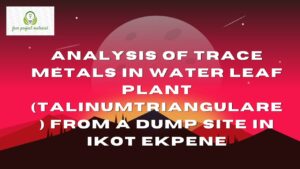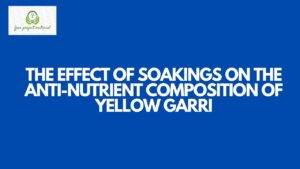ABSTRACT
Phytochemical screening of fresh tomatoes were carried out using standard analytical test. Phytochemical screening results showed that the fresh tomatoes sample had high concentration of flavonoids and cardiac glycosides which is potent in inhibiting cancer activation. Saponin were indicated in moderate concentrations, the concentration of Tannin were occurred in Trace whereas Alkaloid were absent which is not detected in the sample. The effect of fresh tomatoes and the medicinal role of the phytochemical which possess therapeutic properties are examined.
TABLE OF CONTENTS
Title page – – – – – – – – – i
Certification – – – – – – – – – ii
Acknowledgement – – – – – – – iii
Abstract – – – – – – – – – iv
Table of contents – – – – – – – – v-viii
CHAPTER ONE
1.0 INTRODUCTION
1.1 Background of the study – – – – – – 1-3
1.2 Aim and Objective of the study – – – – – 3-4
1.3 Scope and Limitation of the study – – – – 4
1.4 Definition of terms – – – – – – – 4
CHAPTER TWO
2.0 LITERATURE REVIEW
2.1Description of Tomato (Solanum lycopersicum) – – 5-6
2.2 Classification of Tomato (Solanum lycopersicum) – – 6-7
2.3 Health benefits of Tomato (Solanum lycopersicum) – – 7-9
2.4 Culinary use of Tomato (Solanum lycopersicum) – – 9
2.5 Medicinal use of Tomato (Solanum lycopersicum) – – 10-12
2.6 Nutrition value of Tomato(Solanum lycopersicum) – – 12-13
2.7 Phytochemical – – – – – – – – 13-14
2.7.1 Tannins – – – – – – – – 14-15
2.7.2 Alkaloids – – – – – – – – 15-16
2.7.3 Saponin – – – – – – – – 16-17
2.7.4 Cardiac glycoside – – – – – – – 17
CHAPTER THREE
3.0 Material and Method
3.1Source Of Sample Collection – – – – – – 18
3.2 Laboratory Preparation Of Sample – – – – – 18
3.3 Extraction Of The Sample – – – – – – 18
3.4 Phytochemical Screening Of the Sample- – – – 19
3.4.1 Test for Alkaloid- – – – – – – – 19
3.4.3 Test for flavonoid- – – – – – – – 19
3.4.4 Test for Tannin (ferine chloride test)- – – – – 20
3.4.5 Test for Cardiac Glycosides- – – – – – 20
CHAPTER FOUR
4.0 Results and Discussion
4.1Results – – – – – – – – – 22
4.2 Discussions – – – – – – – – 23-24
CHAPTER FIVE
5.0 Conclusion and Recommendation
5.1 Conclusion – – – – – – – – 25
5.2 Recommendation – – – – – – – 25
References
CHAPTER ONE
1.0 INTRODUCTION
1.1 BACK GROUND OF THE STUDY
Medicinal plants remain nature’s reservatory of biological active compounds with biological and therapeutic (Oyedemi et al, 2010). These biological compounds are called phytochemicals. They are naturally occurring chemical compounds in plants, which protect plant cells from environmental hazards such as pollution, stress, drought, uv exposure and pathogenic attack (Ali and Alyurainy; 2006). These compounds are considered secondary plant metabolities and have shown to posses various biological effects, which provide the scientific base for the herbs in the traditional medicine of many ancient communities. They have been described as antibiotic, antifungal and anti viral and therefore able to protect plants from pathogens (Rehab et al; 2018). It has been estimated that 14-28% of higher plant especies are used medicinally and that 74% of pharmacologically active plant derived components were discovered after following up on ethno- medicinal use of the plants (Watson et al., 2001).
Phytochemical are used for various purposes such as pharmaceuticals agrochemicals, flavors, etc; and their chemicals structures are composed of phytochemicals such as (Patra, 2012).
Phytochemical are biologically active, naturally occurring chemical compounds found in plant which provide health benefits for humans as medicinal ingredient and contribute to the plant’s colour, aroma and flavor. In general, the plant chemical that protect plant from environment hazards such as pollution, stress, drought, uv exposure and pathogenic attack are called as phytochemicals (Gibson ., 1998; Mathal, 2000).
Tomato, solanum lycopersicum (Linn), previously known as lycopersicum esculentum (Mill) is a red berry fruit (lapt, 2016). Ir belongs to the plant family solanaceae and genus solanum (Sarah et al., 2003).
Tomato is one of the most important vegatabkle worldwide because of its high consumption, year round availability and large content of health related components (Krishna et al., 2013). It is used as huice, soup, Ketchup or paste (Dillis and Trichopoulour, 2010). Although tomatoes are often closely associated with Italian couisine, they are actually originally native to the Western side of south America in the region occupied by Columbia, Ecuador, peru, chile and the western half of Bolivia.
Tomato is very rich in vitamins, minerals , essential amino acids, sugars, dietary fibers and lycopene, and antioxidant that reduced the danger related to many cancers and neurodegenerative diseases (Srinivasan, 2010).
Today tomatoes are enjoyed worldwide to turn of 130 million tons per year by the largest tomato producing country, which is china (with approximately 34 milloin tones of production) followed by united stated, Turkey and India (Parnell et al; 2014). The plant require relatively cool weather for optimum (Rodriguesz, 2007).
1.2 AIM AND OBJECTIVE OF THE STUDY
The aim of this research work is to carryout phytochemical screening of tomato with the following objectives.
- To determine Alkaloid content of tomato
- To determine flavonoid contents of tomato
- To determine saponins content of tomato
- To determine cardinal content of tomato
1.3 SCOPE AND LIMITATION OF THE STUDY
This research work focus only on the phytochemical screening of tomato due lack of adequate materials, time, financial constraint and the level of education.
1.4 DEFINITION OF TERMS
Phytochemical: is defined as bioactive nutrient plant chemicals in fruits, vegetable grains, and other plant food that may provide desirable health benefits beyond basis provide desirable the risk of major chronic diseases (Liu, 2004).
Tomato: A glassy red, or occasionally yellow pulpy edible fruit that is eaten as a vegetable or in salad.


